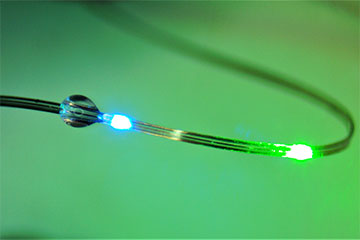
Flexible fibers embedded with sensors and light sources have been used to manipulate and monitor the connections between the brain and the digestive tract of freely moving mice. [Image: MIT]
Scientists at the Massachusetts Institute of Technology (MIT) and Duke University in the United States have reportedly created multifunctional optical fibers that can be used to probe and control the neuronal circuits connecting the brain to the digestive system (Nat. Biotechnol., doi: 10.1038/s41587-023-01833-5). By embedding sensors, light sources, electrodes and microfluidic channels into polymer fibers, the researchers created implantable devices that they say allowed them to manipulate sensory cells inside the intestines of freely moving mice.
The multifunctional fibers provide a wireless interface for optogenetic stimulation, which allows biological processes to be probed with millisecond precision by activating light-sensitive molecules within specific cells. In this study, the aim was to measure signals passing between the brain and the nervous system of the gut, which control feelings of hunger and satiety through both neuronal communication and hormone release.
Probing and controlling
The fiber-based devices were fabricated using thermal drawing, a single-step process that allows multiple microelectronic components to be incorporated into a continuous length of fiber—including micro-LEDs for optogenetics, thermal sensors for measuring tissue temperature, and microfluidic channels for drug and gene delivery. The drawing process can also be adapted to create more rigid implants for use in the brain, as well as softer and more compliant versions that can be inserted into the tortuous digestive tract without damaging the lining.
By stimulating cells that produce cholecystokinin, a hormone that creates a feeling of fullness, the researchers were able to suppress the appetite of animals that had not eaten for several hours.
A wireless circuit provides real-time control and measurement of the implants, which in one experiment allowed the researchers to release sucrose into the guts of mice when they entered a specific chamber of the cage. This activates a dopamine response in the brain, prompting the animals to return to the same chamber in search of the dopamine reward. In further experiments, the researchers found that they could induce same reward-seeking behavior by stimulating nerve endings in the gut, showing that biological processes in the digestive system can generate a response in the brain.
Further evidence for this crosstalk came from experiments that aimed to influence the feeding behavior of the mice. By stimulating cells that produce cholecystokinin, a hormone that creates a feeling of fullness, the researchers were able to suppress the appetite of animals that had not eaten for several hours. A similar effect was observed when they triggered the release of a peptide that curbs the appetite after consuming very rich foods.
Studying neurological conditions
The team now plans to use the multifunctional devices to study neurological conditions that are believed to have a gut–brain connection, such as autism and Parkinson’s disease. “Maybe there is an opportunity for us to begin managing some of those conditions by manipulating the peripheral gut–brain circuits in a way that does not directly ‘touch’ the brain,” comments senior author Polina Anikeeva from MIT.
